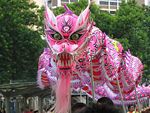Dragon dance

Dragon dance (simplified Chinese: 舞龙; traditional Chinese: 舞龍; pinyin: wǔ lóng) is a form of traditional dance and performance in Chinese culture. Like the lion dance it is most often seen in festive celebrations. Chinese people often use the term "Descendants of the Dragon" (龍的傳人 or 龙的传人, lóng de chuán rén) as a sign of ethnic identity.
In the dance, a team of people carry the dragon — which is an image of the Chinese dragon — on poles. The lead dancers lift, dip, thrust, and sweep the head, which may contain animated features controlled by a dancer and is sometimes rigged to belch smoke from pyrotechnic devices. The dance team mimics the supposed movements of this river spirit in a sinuous, undulating manner. The movements in a performance traditionally symbolise historical roles of dragons demonstrating power and dignity. The dragon dance is a highlight of Chinese New Year celebrations held worldwide in Chinatowns around the world.
Dragons are believed to bring good luck to people, which is reflected in their qualities that include great power, dignity, fertility, wisdom and auspiciousness. The appearance of a dragon is both frightening and bold but it has a benevolent disposition, and so eventually became an emblem to represent imperial authority.
One of the illustrations at right shows a Double Dragon Dance, rarely seen in western exhibitions, with two troupes of dancers intertwining the dragons. Even rarer are dances with the full array of 9 dragons (Kawlung), since 9 is a 'perfect' number. Such dances involve large number of participants from various organizations, and are often only possible under the auspices of the greater community.
History
The Dragon Dance itself originated during the Han Dynasty and was started by the Chinese who had shown great belief and respect towards the dragon. It is believed to have begun as part of the farming and harvest culture, also with origins as a method of healing and preventing sickness. It was already a popular event during the Song Dynasty where it had become a folk activity and like the lion dance, was most often seen in festive celebrations.
From its origins in combining stylized depictions of natural animals, the Chinese dragon evolved to become a mythical creature revered in Chinese culture. Its physical form is a combination of many animals, including the horns of a stag, ears of a bull, eyes of a rabbit, claws of a tiger and the scales of a fish, all on a long serpent’s body. With these traits, it was believed that dragons were amphibious with the ability to move on land, fly through the air and swim in the sea, bestowing them roles as governors of cloud and rain in weather.
As the dragon gives people a feeling of great respect, it is often called the Sacred Dragon. The emperors of ancient China considered themselves as the dragon. The Dragon is also the emblem of Imperial Authority. It symbolises supernatural power, goodness, fertility, vigilance and dignity.
The dragon dance was started by the Chinese who had shown great belief and respect towards the dragon. It is an important item of the Chinese Culture and tradition. Dragon Dance has spread throughout China and to the whole world. It becomes a special performance of arts in the Chinese physical activities. It symbolizes the bringing of good luck and prosperity in the year to come for all the human beings on earth. According to ancient history, during the period of Chun Chiu, the learning of Chinese Martial Arts was very popular and in the spare time, dragon dance was also being taught to students to provide more encouragement.
In the Qing Dynasty, the Dragon Dance team of the province of Foochow had been invited to perform in Peking and had been greatly praised and admired by the Ching Emperor, which earned great fame for the team.